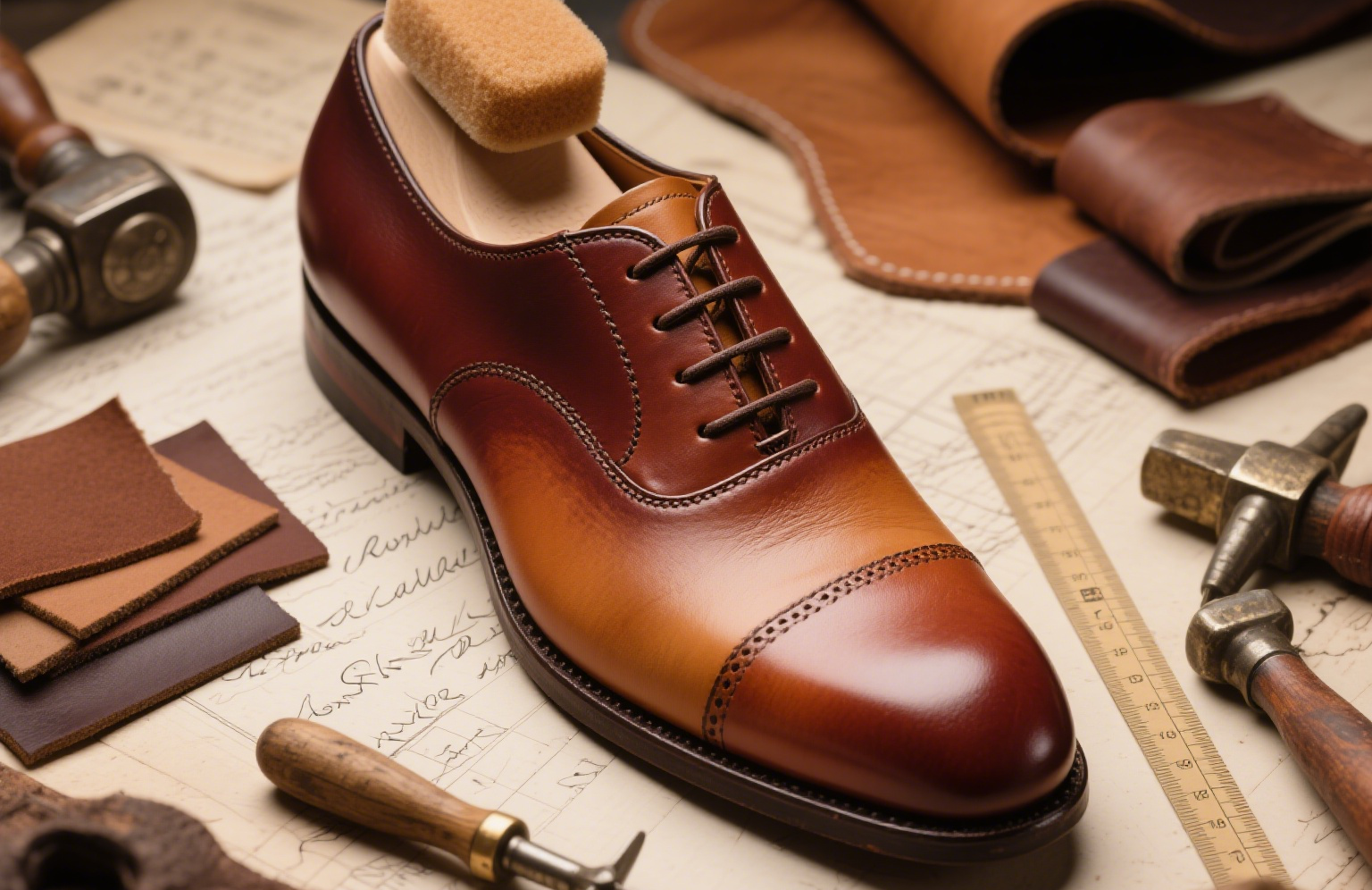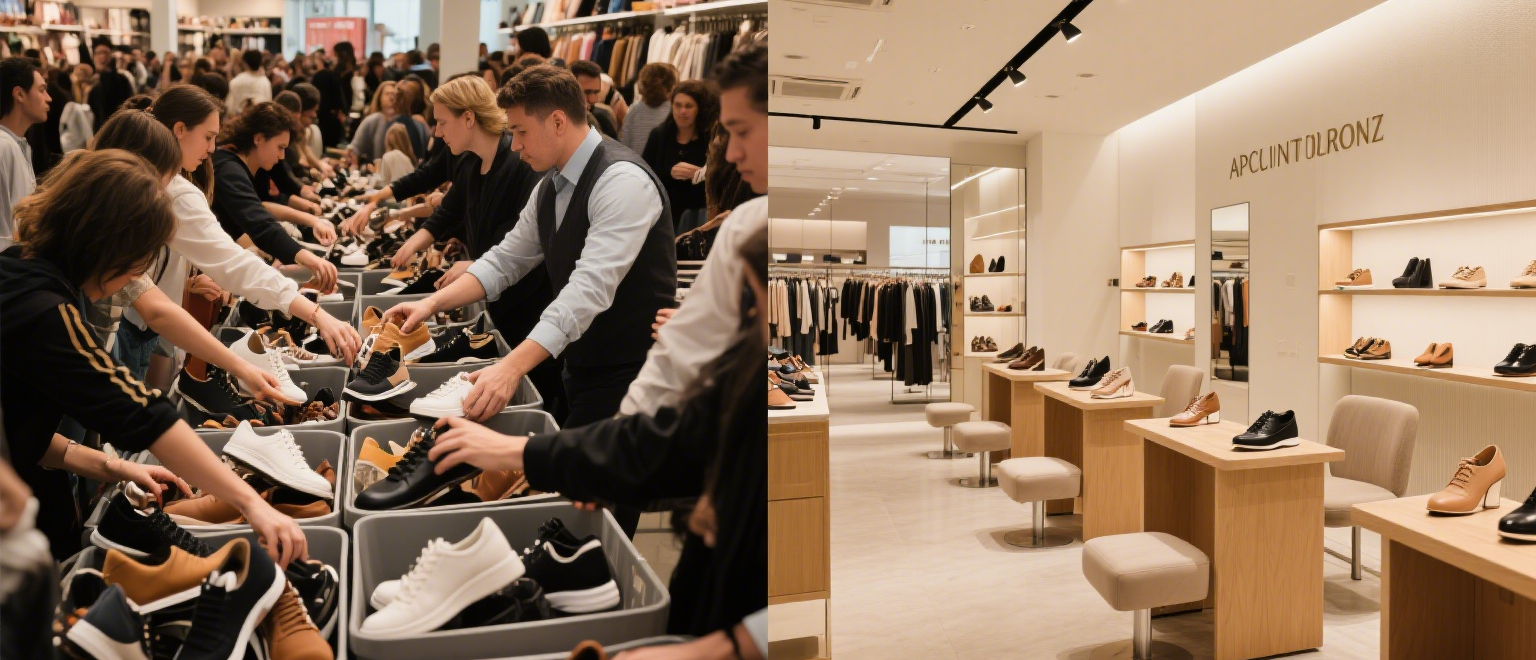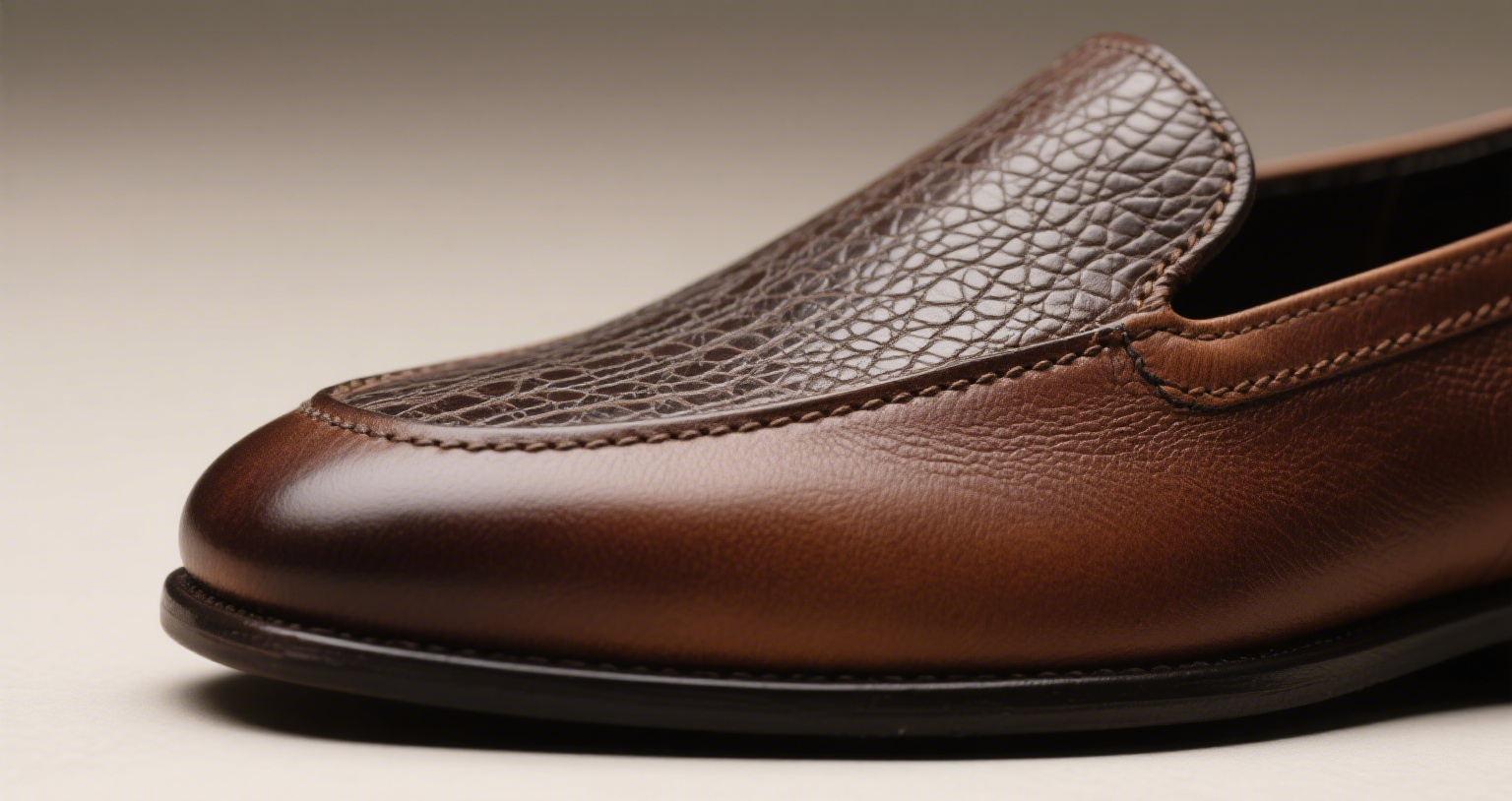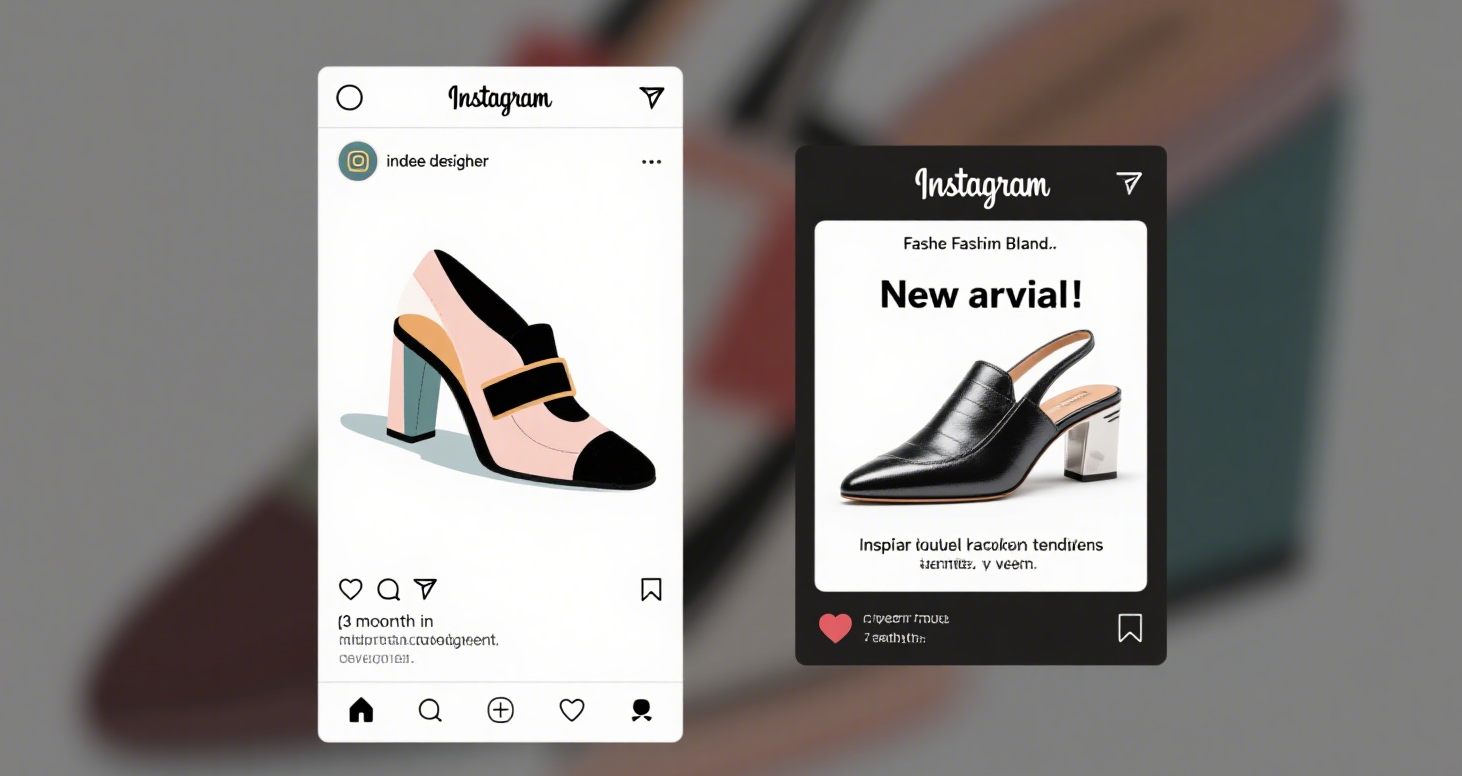Are you wondering about the impact of fast fashion on the creative and unique world of independent shoe design? It's a complex and often challenging relationship.
Fast fashion brands significantly impact independent shoe designers by rapidly replicating their unique designs at lower prices, leveraging economies of scale and quick production cycles. This practice floods the market with similar-looking, cheaper alternatives, potentially eroding the independent designers' market share, intellectual property, and ability to compete on price, often forcing them to differentiate strongly on quality, sustainability, or unique artistic vision.
 As the founder of Lucas, a shoe manufacturer, I've seen how fast fashion has reshaped the industry. While we focus on quality production, the race to market with trendy, affordable options directly affects how independent designers strategize their collections. It's a constant balancing act between speed, cost, and originality.
As the founder of Lucas, a shoe manufacturer, I've seen how fast fashion has reshaped the industry. While we focus on quality production, the race to market with trendy, affordable options directly affects how independent designers strategize their collections. It's a constant balancing act between speed, cost, and originality.
How does fast fashion affect independent shoe designers? Are you curious about the specific ways fast fashion challenges smaller, independent shoe designers? The effects are profound and multifaceted. Fast fashion significantly impacts independent shoe designers by accelerating trend cycles, leading to rapid replication of their unique designs, which are then mass-produced at lower prices. This erodes the value of original design, makes it difficult for independent designers to compete on price, pressures them to produce faster, and often leads to intellectual property infringement, thereby reducing their market share and profitability.
From my perspective in shoe manufacturing, the pressure from fast fashion means that what's "new" today can be "old" tomorrow. Independent designers, unlike large brands who can amortize design costs over huge volumes, find it very hard to keep up without compromising their unique vision or financial viability.
The Multi-Faceted Impact of Fast Fashion on Independent Shoe Designers
Fast fashion creates a challenging environment for independent shoe designers, who often operate on different business models and principles.
- 1. Rapid Replication and Idea Dilution:
- Fast fashion thrives on speed. Designers working for fast fashion brands constantly monitor trends, including those emerging from high fashion runways and independent artists. When a unique design from an independent shoe designer gains traction, fast fashion brands can quickly produce similar-looking shoes, often within weeks.
- This rapid replication saturates the market with diluted versions of original ideas. It makes the unique design feel less exclusive and more commonplace, diminishing its perceived value and uniqueness for the original creator.
- 2. Price Undercutting and Competition:
- Independent designers typically operate with lower production volumes, higher material costs (often prioritizing quality or unique sourcing), and higher design and development overhead per unit. This means their retail prices are necessarily higher.
- Fast fashion brands, with their massive economies of scale, extensive supply chains (often leveraging low-cost labor and materials), and optimized production processes, can produce shoes at a fraction of the cost. They then sell these shoes at significantly lower prices, making it nearly impossible for independent designers to compete on price.
- 3. Accelerated Trend Cycles:
- Fast fashion speeds up the entire fashion cycle. What was trendy a few months ago might be considered "out" by the time an independent designer, with longer production timelines, can bring their original collection to market. This constant churn creates immense pressure on independent designers to be perpetually "ahead of the curve" or risk their designs feeling dated.
- 4. Intellectual Property Infringement:
- While direct, identical copying is legally risky, fast fashion often engages in "design inspiration" that borders on infringement. They take the essence of an independent designer's unique silhouette, embellishment, or concept and tweak it just enough to avoid legal battles, yet capitalizing on the original idea's appeal. This deprives the original creator of deserved recognition and profit.
- 5. Erosion of Perceived Value:
- When high-quality, unique designs are quickly mimicked and sold cheaply, it can erode the broader public's perception of "value" in design. Consumers might wonder why an independent designer's shoe costs substantially more when a similar-looking alternative is readily available at a fraction of the price, not fully understanding the differences in craftsmanship, materials, ethical production, or original artistry.
- 6. Pressure to Compromise:
- To survive, some independent designers might feel compelled to compromise on their original vision, quality, or ethical production practices to try and compete on speed or price, potentially undermining their brand's core values.
From the perspective of a manufacturer like Lucas, we witness the tension between detailed, quality-driven production and the demands for fast, cheap output. Independent designers often lean on us for durable, high-quality production, but the market created by fast fashion is a constant challenge.
| Impact Category | How Fast Fashion Affects Independent Shoe Designers |
|---|---|
| Design Replication | Rapidly copies unique designs, diluting originality and market appeal. |
| Price Competition | Undercuts prices with mass-produced, cheaper alternatives. |
| Trend Acceleration | Shortens design relevance; pressures faster production cycles. |
| IP Infringement | "Inspiration" borders on copying, depriving designers of fair profit. |
| Value Erosion | Devalues original design in consumer perception due to cheap imitations. |
| Pressure to Compromise | Forces designers to potentially sacrifice quality/ethics for speed/cost. |
Will fast fashion dominate the footwear market completely?
Are you concerned that fast fashion might entirely monopolize the footwear market, leaving no room for other players? The forecast suggests a more nuanced outcome.
Fast fashion will likely continue to hold a significant and dominant share of the footwear market, especially in trendy and affordable segments, but it will not completely dominate it. Niche markets, driven by consumer demand for quality, sustainability, bespoke design, luxury, and personalized experiences, will continue to thrive, allowing independent designers, luxury brands, and specialized athletic footwear companies to coexist and cater to distinct consumer segments.
 At Lucas, we've seen how dynamic the footwear market is. While fast fashion certainly reshaped it, there's always a place for quality and unique craftsmanship that big players can't easily replicate.
At Lucas, we've seen how dynamic the footwear market is. While fast fashion certainly reshaped it, there's always a place for quality and unique craftsmanship that big players can't easily replicate.
The Future Landscape: Coexistence, Not Complete Domination
While fast fashion exerts immense pressure, several factors suggest it won't achieve complete dominance over the entire footwear market:
- 1. Demand for Quality and Durability:
- Fast fashion shoes are often designed for short-term wear. Many consumers, however, prioritize durability, comfort, and longevity, especially for everyday wear or specific purposes (e.g., hiking boots, running shoes). These segments require higher quality materials and construction that fast fashion typically does not provide. At Lucas, we emphasize the durability and quality construction that sets us apart from the rapid, disposable model.
- 2. Rise of Sustainable and Ethical Consumption:
- A growing segment of consumers is increasingly aware of the environmental and social costs of fast fashion (waste, labor practices). They are willing to pay a premium for footwear produced ethically, sustainably, and with transparent supply chains. Independent designers and many specialized brands often align better with these values.
- 3. Desire for Uniqueness and Exclusivity:
- Fast fashion, by its nature, homogenizes trends. There will always be a segment of consumers who seek unique, distinctive footwear that reflects their individual style and stands out from mass-produced items. This desire supports independent designers and niche brands offering limited-edition or handcrafted pieces.
- 4. Performance and Specialization:
- Complex segments like high-performance athletic footwear, orthopedic shoes, or professional safety footwear require extensive research and development, specialized materials, and precise engineering. Fast fashion brands generally lack the deep expertise and resources to compete effectively in these specialized areas.
- 5. Luxury Market Resilience:
- The luxury footwear market operates on principles of heritage, craftsmanship, premium materials, and brand prestige, which are antithetical to fast fashion's model. Consumers in this segment buy for investment, status, and artistry, ensuring its continued existence alongside fast fashion.
- 6. Personalization and Customization:
- The future of footwear may increasingly involve personalized or customized options. While some large brands offer limited customization, independent designers or smaller ateliers are better positioned to offer truly bespoke experiences.
So, while fast fashion will certainly maintain its substantial market share in the accessible, trend-driven segments, it is unlikely to displace the entire footwear industry. The market will likely remain diverse, with fast fashion, luxury, performance, sustainable, and independent brands coexisting and catering to different consumer values.
| Segment | Why Fast Fashion Won't Completely Dominate |
|---|---|
| Quality/Durability | Demand for long-lasting, comfortable shoes with better materials. |
| Sustainable/Ethical | Growing consumer preference for eco-conscious and fair-labor products. |
| Uniqueness/Exclusivity | Desire for distinctive, non-mass-produced designs; anti-homogenization. |
| Performance/Specialization | Need for specialized R&D, engineering in athletic, orthopedic, safety. |
| Luxury Market | Driven by heritage, craftsmanship, prestige; unaffected by low-price. |
| Personalization/Customization | Emerging demand for tailored and bespoke footwear experiences. |
Why are fast fashion shoes so much cheaper than designer shoes?
Are you curious about the vast price difference between a pair of fast fashion shoes and high-end designer footwear? The disparity lies in their fundamental business models and values.
Fast fashion shoes are significantly cheaper than designer shoes primarily due to mass production, use of lower-cost synthetic materials, reliance on low-wage labor, minimal research and development investment, rapid trend replication, and efficient, often less ethical, supply chains. In contrast, designer shoes prioritize expensive, high-quality materials, meticulous craftsmanship, substantial R&D and original design costs, ethical production, and brand prestige, all leading to higher pricing.
 As a manufacturer at Lucas, I can tell you that the material choices and the labor hours put into a shoe directly translate to cost. Fast fashion minimizes these inputs, while designer brands maximize them.
As a manufacturer at Lucas, I can tell you that the material choices and the labor hours put into a shoe directly translate to cost. Fast fashion minimizes these inputs, while designer brands maximize them.
The Cost Discrepancy: Fast Fashion vs. Designer Footwear
The immense price gap between fast fashion and designer shoes is a direct result of their differing philosophies and operational choices:
- 1. Materials and Craftsmanship:
- Fast Fashion: Primarily uses inexpensive, often synthetic, materials like PU (polyurethane) leather, various plastics, and low-grade textiles. The construction is usually simplified, machine-heavy, and designed for quick assembly rather than durability or intricate detailing. The focus is on visual appeal for a short lifespan.
- Designer Shoes: Employs premium, often natural, materials such as genuine leather (calfskin, exotic leathers), suede, silk, and high-quality textiles. Craftsmanship involves significant handwork, traditional techniques (like Goodyear welting or Blake stitching), and meticulous attention to detail, which are labor-intensive and require highly skilled artisans.
- 2. Design and Development (R&D):
- Fast Fashion: Spends very little on original research and development. Their design process involves rapidly replicating trending styles seen on runways or from independent designers. This "copycat" approach saves considerable time and money on design fees and experimental prototyping.
- Designer Shoes: Invests heavily in original design, trend forecasting, R&D for new materials and constructions, and extensive prototyping. A significant portion of the price reflects the intellectual property, creativity, and development costs of unique, innovative designs.
- 3. Labor Costs and Production Volume:
- Fast Fashion: Relies on massive production volumes from factories often located in regions with very low labor costs and sometimes questionable ethical standards. The sheer scale allows for extreme economies of scale, driving down the per-unit cost.
- Designer Shoes: Often produced in smaller batches, sometimes in countries with higher labor costs (e.g., Italy, Spain, Portugal), reflecting skilled labor and sometimes more ethical manufacturing practices. The lower volume means fixed costs are spread over fewer units, increasing per-unit price.
- 4. Supply Chain Efficiency and Speed:
- Fast Fashion: Operates on an incredibly agile and often less transparent supply chain designed for maximum speed and minimal cost, from material sourcing to final delivery. This hyper-efficiency in logistics contributes to lower prices.
- Designer Shoes: May prioritize ethical sourcing, traceability, and specific craftsmanship-based timelines, which might not be as "fast" or as cheap as the fast fashion model.
- 5. Brand Marketing, Overhead, and Perceived Value:
- Fast Fashion: Marketing is often digital, high-volume, and less focused on "prestige." Their low price point is itself a marketing strategy.
- Designer Shoes: A significant portion of the price reflects brand prestige, heritage, high-end marketing campaigns, exclusive retail environments, and the perception of luxury and status associated with the brand. This "brand equity" adds significant value.
At Lucas, we understand the economics of both. We can facilitate volume production for more accessible lines, but when a client demands premium materials and intricate construction, the cost naturally goes up—a direct reflection of the resources and artistry involved.
| Cost Factor | Fast Fashion Shoe Production | Designer Shoe Production |
|---|---|---|
| Materials | Inexpensive synthetics (PU, plastic), low-grade textiles. | Premium genuine leathers, natural fibers, exotic materials. |
| Craftsmanship | Machine-dominant, simplified construction, designed for disposal. | Significant handwork, traditional techniques, meticulous detailing, durability. |
| Design/R&D | Minimal; rapid replication of trending styles. | Significant investment in original design, innovation, and prototyping. |
| Labor Costs | Low-wage regions, high volume production, maximum efficiency. | Often higher-wage regions, skilled artisans, smaller batch sizes. |
| Supply Chain/Logistics | Hyper-efficient, price-optimized, sometimes less transparent. | May be slower, prioritize ethical sourcing, less cost-driven. |
| Brand/Marketing/Overhead | High volume, digital, price-point driven marketing. | Focus on prestige, luxury experience, high-end campaigns, exclusive retail. |
Are fast fashion brands copying independent designers?
Are you wondering if fast fashion brands directly copy the work of independent designers? The answer is often 'yes,' though they use careful language to avoid legal repercussions.
Yes, fast fashion brands frequently copy independent designers by "deriving inspiration" from their unique concepts, silhouettes, and aesthetic elements, then rapidly producing similar versions at lower price points. While direct, identical copying of copyrighted elements might be avoided, they typically mimic the distinctive look and feel of original designs just enough to capitalize on the trend without extensive R&D or risk-taking, often infringing on the spirit of intellectual property.
 From my perspective in manufacturing, we see samples come in. It's clear that many fast fashion designs are very "inspired" by what's popular on the runway or by emerging talents. It’s part of their business model.
From my perspective in manufacturing, we see samples come in. It's clear that many fast fashion designs are very "inspired" by what's popular on the runway or by emerging talents. It’s part of their business model.
The Nuance of "Copying" in Fast Fashion
The practice of fast fashion "copying" independent designers is a well-documented and controversial aspect of the industry. It's rarely a direct, identical replica but rather a rapid interpretation and mass production of an original concept.
- 1. The "Inspiration" Loophole:
- Fashion design often operates in a legal grey area regarding intellectual property. While specific textile prints or logos can be copyrighted, a shoe's silhouette, cut, or general aesthetic is much harder to protect. Fast fashion brands exploit this by arguing they are "inspired by" trends, which often means taking a new, distinctive concept from a high-end designer or independent creator and creating a similar, cheaper version.
- 2. Speed to Market:
- Independent designers typically present their collections on runways or in showrooms, which are then quickly observed by fast fashion trend scouts. These scouts rapidly send images and specifications to their manufacturing teams. The goal is to get a similar product into stores within weeks, while the original designer might still be taking orders for their (more ethically produced) initial run.
- 3. Mass Production of "Trends":
- Fast fashion's business model is to identify a burgeoning trend and democratize it by making it accessible to the masses at low prices. Independent designers often create these initial trends through their unique, innovative work. Fast fashion then capitalizes on this creative output without bearing the R&D costs or design risks.
- 4. Lack of Attribution and Compensation:
- The core issue for independent designers isn't just the copying itself, but the lack of attribution or compensation. Their original creative effort, which underpins the trend, is exploited for profit by large corporations without any acknowledgment or financial benefit to the source.
- 5. Erosion of Uniqueness and Brand Value:
- When an independent designer's distinct aesthetic is rapidly replicated and sold cheaply, it dilutes the originality and uniqueness that made their brand special. This can be devastating for a small brand trying to build a reputation based on innovation and unique vision.
While direct legal battles are sometimes fought (and often lost by smaller designers due to high legal costs), the pervasive nature of "inspired by" designs means that many fast fashion items clearly draw heavily from the unique creations of independent and luxury designers without formal permission or compensation.
| Aspect of Copying | Fast Fashion Practice | Impact on Independent Designers |
|---|---|---|
| Design Source | Observes emerging trends from runways, independent designers. | Their original ideas are used without credit or payment. |
| Speed of Action | Rapidly produces "inspired" versions within weeks of original's debut. | Undercuts their sales window and exclusive appeal. |
| Legal Nuance | Operates within "inspiration" loophole, avoiding direct copyright. | Costly and difficult for independent designers to seek legal recourse. |
| Market Saturation | Floods market with cheap versions of unique concepts. | Dilutes originality; reduces perceived value of their work. |
| Ethical Aspect | Creative labor of others is leveraged without compensation. | Feels exploited; undermines creative process and livelihood. |
How do consumers choose between fast fashion and indie shoe brands? Are you a consumer making purchasing decisions between fast fashion and independent shoe brands? Your choices reflect a complex interplay of priorities. Consumers choose between fast fashion and independent shoe brands based on priorities like price, trend relevance, quality, uniqueness, ethical considerations, and brand values. Fast fashion appeals to those seeking affordability and quick trend adoption, while indie brands attract consumers valuing craftsmanship, durability, sustainable practices, unique designs, and supporting smaller, values-driven businesses.
From my perspective at Lucas, we see clients who serve both ends of this spectrum. Ultimately, it comes down to what a consumer prioritizes in their footwear – temporary trend or lasting value.
Consumer Motivations: Fast Fashion vs. Independent Shoes
Consumer choice between fast fashion and independent shoe brands is a reflection of individual values, budget, and lifestyle:
- 1. Price and Affordability:
- Fast Fashion: The primary driver. Consumers on a tight budget or those who want to frequently update their shoe collection for low cost gravitate towards fast fashion. They prioritize quantity and immediate trend relevance over durability or long-term value.
- Independent Brands: Typically higher priced. Consumers choosing these understand they are paying for higher quality materials, better craftsmanship, original design, ethical production, or a desire to support small businesses. They view the purchase as an investment or a statement piece.
- 2. Trend Relevance and Speed:
- Fast Fashion: Appeals to individuals who want to wear the latest trends immediately. Their model satisfies the desire for "newness" and fleeting styles.
- Independent Brands: May produce less frequently, focusing on seasonless designs or slower, more thoughtful trend interpretation. Consumers here might prefer timeless pieces or designs that speak to individual style rather than mass trends.
- 3. Quality and Durability:
- Fast Fashion: Generally lower quality, designed for a few wears. Consumers accept this trade-off for the low price.
- Independent Brands: Often emphasize high-quality materials and construction, aiming for longevity and comfort. Consumers willing to invest expect their shoes to last. As a manufacturer, this is where Lucas excels, offering the quality that independent brands cherish.
- 4. Uniqueness and Originality:
- Fast Fashion: Leads to widespread adoption of similar styles, fostering a homogenous look.
- Independent Brands: Attract consumers seeking unique designs that stand out, expressing individuality and avoiding mass-produced items. They value the artistry and distinctiveness of a designer's vision.
- 5. Ethical and Sustainable Considerations:
- Fast Fashion: Often associated with exploitative labor practices and significant environmental impact. Price-conscious consumers might overlook these concerns.
- Independent Brands: Many explicitly promote ethical production, fair wages, sustainable materials, and reduced environmental footprints, appealing to values-driven consumers.
- 6. Brand Story and Connection:
- Fast Fashion: Focuses on accessibility and mass appeal, with little emphasis on a brand narrative beyond being trendy and cheap.
- Independent Brands: Often have a compelling founder story, a clear mission, or a direct connection to the creative process. Consumers may choose them to support an artist, a local business, or a brand whose values align with their own.
Ultimately, consumer choice reflects a hierarchy of needs and values. Some prioritize immediate gratification and low cost, while others prioritize long-term value, ethical considerations, and personal expression.
| Consumer Priority | Choice for Fast Fashion | Choice for Independent Shoe Brands |
|---|---|---|
| Price/Affordability | Primary consideration; seeks lowest cost. | Willing to pay more for quality, ethics, unique design. |
| Trend Following | Wants latest trends instantly, frequently updates. | Prefers lasting style, unique aesthetic; less driven by fleeting trends. |
| Quality/Durability | Accepts mass-produced, short-lived quality for price. | Seeks high-quality materials, craftsmanship, longevity. |
| Uniqueness/Originality | Values being "on trend" with widely available styles. | Seeks distinctive designs that express individuality. |
| Ethical/Sustainable | May overlook or ignore; focuses on immediate gratification. | Prioritizes fair labor, eco-friendly materials, transparency. |
| Brand Connection | Minimal connection; transactional relationship with brand. | Values supporting small businesses, artists, and ethical brands; connects with story. |
Conclusion Fast fashion significantly impacts independent shoe designers by quickly copying designs at lower prices, accelerating trend cycles, and eroding perceived value. While it dominates accessible segments, it won't entirely displace the footwear market; demand for quality, uniqueness, sustainability, and specialized performance ensures independent and luxury brands thrive. Consumers choose based on price, trend, quality, and ethical alignment.
